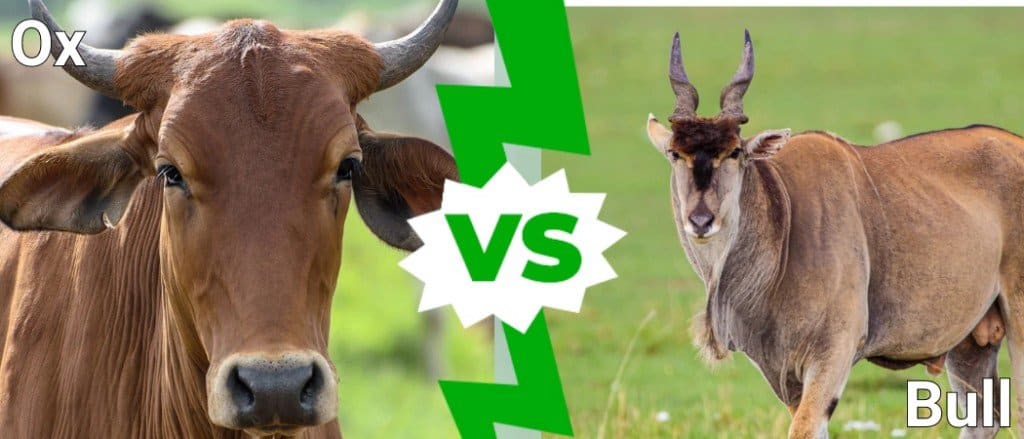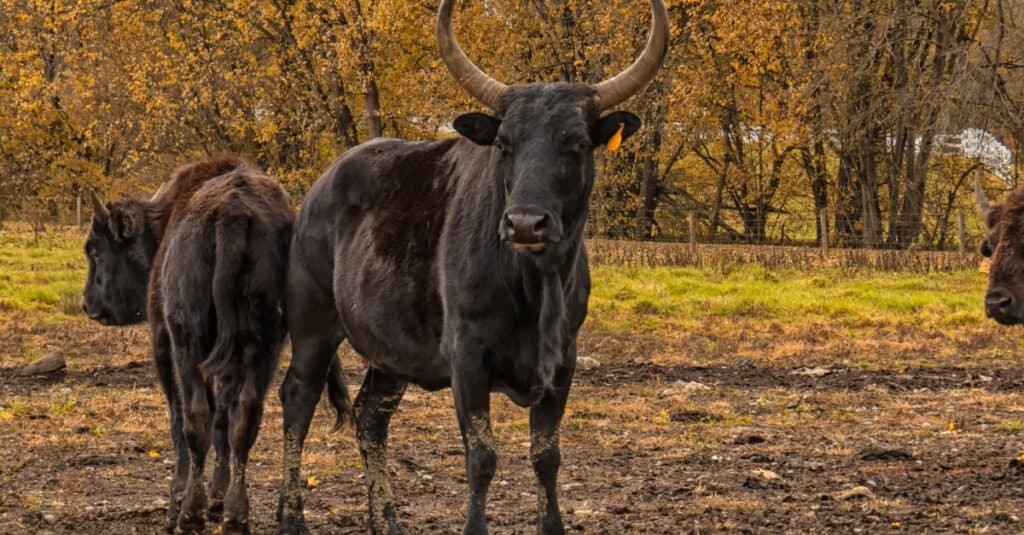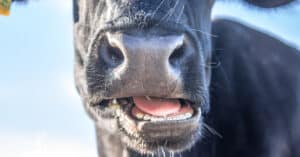Ox vs Bull: What’s the Difference?
@media (min-width: 481px) {
.mobile-top-content {
display: none;
}
}
#mobileTopContentCTACarouselControls { overflow: hidden; text-overflow: ellipsis; white-space: nowrap; }
.mobile-top-content .more { color: #fff; }
.mobile-top-content a { color: #fff; text-decoration: underline; }
.mobile-top-content a:hover { color: #fff; text-decoration: underline; }
@media (max-width: 480px) {
.mobile-top-content {
background-color: #06a10b;
color: #fff;
text-align: center;
/*height: 60px;
padding-top:5px;*/
font-size:80%;
/* display: block; */
margin: 0px -30px;
}
}
If you have always wondered what the differences are between ox vs bull, you’re in the right place. While both of these animals belong to the same species, known as Bos taurus, there are many subtle differences between them. While this answer may surprise you, there are many things you can learn about these two hooved creatures!
In this article, we will discuss the primary differences between ox and bull, including their differences in breeding and gender. We will discuss these creatures primarily as domesticated animals, given their overall breeding and genetic purposes as cattle. If you’ve always wanted to know more about oxen and bulls, read on to learn more.
Comparing Ox vs Bull

A-Z-Animals.com
| Ox | Bull | |
|---|---|---|
| Gender | Male or female | Always male |
| Size | Larger than bulls on average | Smaller than oxen on average |
| Castrated? | Yes, for the most part | Never, for breeding purposes |
| Breeding | Bred for work, including pulling carts, heavy machinery, and more | Bred for breeding and continuing his preferred bloodline in a herd |
| Price | Less expensive than bulls | More expensive than oxen |
The 5 Main Differences Between Ox vs Bull

– License
There are many key differences between Ox vs bull. For example, bulls are always male while oxen can be either male or female. Oxen breed for entirely different purposes than bulls. Bulls are bred for their bloodline and continuation of a herd of cows, while oxen are bred for heavy duty work, such as pulling and transportation. This also leads to a significant difference in the price or cost of these two animals.
Let’s discuss some of these differences in more detail now.
Ox vs Bull: Gender Differences
One of the main differences between oxen vs bull is their gender. Oxen can be either male or female, though they are often only male, while a bull refers to strictly male cattle. Oxen can be either males or females, depending on their size and hauling capabilities.
Ox vs Bull: Size and Strength
Another key difference between oxen and bull lies in their respective sizes and strengths. For example, oxen are usually both larger and stronger than bulls are, given that they have been bred for work and transportation purposes. Bulls, while still large, have only been bred for further breeding.
However, this does not mean that bulls are not strong. Considering their naturally territorial nature over their herd, bulls can cause some serious damage if they feel as if their herd or their own personal safety is threatened. While oxen remain the larger of the two animals on average, their disposition is calmer and they tend to use their strength for work rather than territorial disputes.
This isn’t to say that oxen weigh more than bulls. While most oxen are physically larger than bulls, they tend to weigh less overall. This is largely due to the fact that bulls have a lot of lean muscle and strength to them, despite their lack of breeding to say otherwise.

Mark Spearman / flickr – License
Ox vs Bull: Castration
Another key difference between ox and bulls lies in their sexual maturity and whether or not they are castrated. A bull is never castrated given that his purpose is for breeding, while nearly all oxen are castrated once they reach sexual maturity. This may be a subtle distinction, but it is a key one. When you consider that bulls are bred to further a herd’s bloodline, it is obvious that they cannot be castrated.

Laura Hedien/Shutterstock.com
Ox vs Bull: Breeding Purposes
We have already mentioned this, but the primary difference between oxen and bulls lies in their breeding purposes. Oxen breed for work, while bulls breed for their genetics and their ability to further the bloodline of their herd. This leads to two very different types of cattle.
While no one would argue that bulls are powerful, oxen have been made much stronger than bulls given their genetic breeding and make up over centuries of farming practices. Bulls are not used to pull heavy machinery or work around a farm like oxen are. The male leader of a herd of cattle is responsible for breeding and protecting his fellow cows and calves, while oxen are made for physical labor.

Ox vs Bull: Overall Cost and Purchase Price
A final difference between ox vs bull lies in their purchase price and overall cost. While it is something that you may not have considered yet, bulls are often more expensive than oxen. This is likely due to the fact that bulls are purchased for their bloodline and good breeding, while oxen are purchased as working cattle and it doesn’t necessarily matter what their bloodline is.
There are many different requirements for breeding bulls, and there are many different breeds and beyond. Oxen on the other hand are not held to the same standards. Oxen are reliable, no matter their bloodline. The purchase price of a reliable breeding bull can be extremely high, especially when compared to the price of a humble working oxen.
More from A-Z Animals
.more-snake-card-image { max-height:140px !important; }
@media (min-width: 481px) {
.mobile-top-content {
display: none;
}
}
#mobileTopContentCTACarouselControls { overflow: hidden; text-overflow: ellipsis; white-space: nowrap; }
.mobile-top-content .more { color: #fff; }
.mobile-top-content a { color: #fff; text-decoration: underline; }
.mobile-top-content a:hover { color: #fff; text-decoration: underline; }
@media (max-width: 480px) {
.mobile-top-content {
background-color: #06a10b;
color: #fff;
text-align: center;
/*height: 60px;
padding-top:5px;*/
font-size:80%;
/* display: block; */
margin: 0px -30px;
}
}
If you have always wondered what the differences are between ox vs bull, you’re in the right place. While both of these animals belong to the same species, known as Bos taurus, there are many subtle differences between them. While this answer may surprise you, there are many things you can learn about these two hooved creatures!
In this article, we will discuss the primary differences between ox and bull, including their differences in breeding and gender. We will discuss these creatures primarily as domesticated animals, given their overall breeding and genetic purposes as cattle. If you’ve always wanted to know more about oxen and bulls, read on to learn more.
Comparing Ox vs Bull

A-Z-Animals.com
| Ox | Bull | |
|---|---|---|
| Gender | Male or female | Always male |
| Size | Larger than bulls on average | Smaller than oxen on average |
| Castrated? | Yes, for the most part | Never, for breeding purposes |
| Breeding | Bred for work, including pulling carts, heavy machinery, and more | Bred for breeding and continuing his preferred bloodline in a herd |
| Price | Less expensive than bulls | More expensive than oxen |
The 5 Main Differences Between Ox vs Bull

– License
There are many key differences between Ox vs bull. For example, bulls are always male while oxen can be either male or female. Oxen breed for entirely different purposes than bulls. Bulls are bred for their bloodline and continuation of a herd of cows, while oxen are bred for heavy duty work, such as pulling and transportation. This also leads to a significant difference in the price or cost of these two animals.
Let’s discuss some of these differences in more detail now.
Ox vs Bull: Gender Differences
One of the main differences between oxen vs bull is their gender. Oxen can be either male or female, though they are often only male, while a bull refers to strictly male cattle. Oxen can be either males or females, depending on their size and hauling capabilities.
Ox vs Bull: Size and Strength
Another key difference between oxen and bull lies in their respective sizes and strengths. For example, oxen are usually both larger and stronger than bulls are, given that they have been bred for work and transportation purposes. Bulls, while still large, have only been bred for further breeding.
However, this does not mean that bulls are not strong. Considering their naturally territorial nature over their herd, bulls can cause some serious damage if they feel as if their herd or their own personal safety is threatened. While oxen remain the larger of the two animals on average, their disposition is calmer and they tend to use their strength for work rather than territorial disputes.
This isn’t to say that oxen weigh more than bulls. While most oxen are physically larger than bulls, they tend to weigh less overall. This is largely due to the fact that bulls have a lot of lean muscle and strength to them, despite their lack of breeding to say otherwise.

Mark Spearman / flickr – License
Ox vs Bull: Castration
Another key difference between ox and bulls lies in their sexual maturity and whether or not they are castrated. A bull is never castrated given that his purpose is for breeding, while nearly all oxen are castrated once they reach sexual maturity. This may be a subtle distinction, but it is a key one. When you consider that bulls are bred to further a herd’s bloodline, it is obvious that they cannot be castrated.

Laura Hedien/Shutterstock.com
Ox vs Bull: Breeding Purposes
We have already mentioned this, but the primary difference between oxen and bulls lies in their breeding purposes. Oxen breed for work, while bulls breed for their genetics and their ability to further the bloodline of their herd. This leads to two very different types of cattle.
While no one would argue that bulls are powerful, oxen have been made much stronger than bulls given their genetic breeding and make up over centuries of farming practices. Bulls are not used to pull heavy machinery or work around a farm like oxen are. The male leader of a herd of cattle is responsible for breeding and protecting his fellow cows and calves, while oxen are made for physical labor.

Ox vs Bull: Overall Cost and Purchase Price
A final difference between ox vs bull lies in their purchase price and overall cost. While it is something that you may not have considered yet, bulls are often more expensive than oxen. This is likely due to the fact that bulls are purchased for their bloodline and good breeding, while oxen are purchased as working cattle and it doesn’t necessarily matter what their bloodline is.
There are many different requirements for breeding bulls, and there are many different breeds and beyond. Oxen on the other hand are not held to the same standards. Oxen are reliable, no matter their bloodline. The purchase price of a reliable breeding bull can be extremely high, especially when compared to the price of a humble working oxen.





